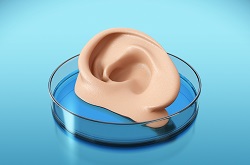‘Hearing loss in a dish’ model tests new treatments
The inner ear is extremely sensitive and can be functionally impaired by noise trauma, toxic drugs, infections, genetic causes and age-related degeneration. Hearing impairment - the most frequent human sensory deficit – is mainly caused by damage or loss of sensory hair cells in the cochlea of the inner ear (in the organ of Corti) that send ‘sound’ signals to the brain. Scientists of the EU-funded OTOSTEM project coordinated by Prof. Löwenheim in Tübingen, wished to address this urgent medical issue by developing drug and cell-based therapies. “Our focus was set on stem cell technology to generate human inner ear models,″ explains deputy project coordinator Dr Hasan Avci. OTOSTEM tested two therapeutic approaches to treat hearing loss: A cell-based treatment introducing stem/otic progenitor cells into the cochlea, and a drug-based treatment to protect or regenerate sensory hair cells. Sources of stem cells to treat hearing loss Researchers utilised various stem cell sources to obtain otic progenitor cells (OPCs). These included native stem cells from foetal and adult human otic tissues, and embryonic or induced pluripotent stem cells. The generated OPCs had to fulfil certain criteria such as in vitro expansion and differentiation into sensory hair cells, supporting cells or otic neuronal cell types. OTOSTEM developed protocols with morphogens or small molecule compounds that induce and determine otic cell fate. OPCs were tested for biological function and absence of tumorigenicity in various ex vivo and in vivo assays. Through comparison of OPC phenotype and gene expression, OTOSTEM partners identified native human stem cells as the stem cell source with the highest otic differentiation potential. Functionality of the generated otic or neuronal cell types was validated in in vitro experiments. Electrophysiological monitoring demonstrated that transplanted cells resembled those of mouse cochlear hair cells. Human otic neuronal progenitors were tested in preclinical animal models of auditory neuropathy. Hearing restoration was achieved and preserved for more than 30 weeks after transplantation with no adverse effects. Hearing loss in a dish model Currently, there is no quantitative cell-based assay for testing drugs specifically toxic to the ear (ototoxicity) in humans, thus even approved drugs bear the risk of causing hearing loss. To address this, and facilitate drug safety studies, the OTOSTEM consortium designed drug screening assays. This ‘hearing loss in a dish model’ employed otic progenitor cell-like cells derived from human induced pluripotent stem cells. The human assay was used for medium-throughput testing of more than 2 000 pharmacological active compounds including FDA-approved drugs. Surprisingly, several of these drugs were identified to be ototoxic. The OTOSTEM consortium has developed novel compounds with otoprotective and otoregenerative activity. Otoprotective compounds prevent death of human ear hair cells. Otoregenerative drugs induce replacement of lost sensory cells. The OTOSTEM findings are of outmost commercial significance to the largely unexplored but growing market of otoprotective and regenerative drugs. Given the association of hearing impairment with neurodevelopment in young, and dementia in older people, there is an imminent unmet need for clinically validated therapies. Industrial partners envisage that the OTOSTEM models can be incorporated into the drug discovery pipeline to enable the identification of new and better drugs to treat hearing loss. As Dr Avci outlines, “With the support of the Seventh Framework Programme, we significantly advanced the development of novel therapies against hearing loss and we are eager to continue our success within the H2020 programme.”
Keywords
OTOSTEM, hearing, stem cell, cochlea, inner ear, otic progenitor cell (OPC)

